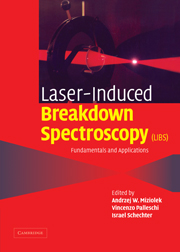Book contents
- Frontmatter
- Contents
- List of contributors
- Preface
- 1 History and fundamentals of LIBS
- 2 Plasma morphology
- 3 From sample to signal in laser-induced breakdown spectroscopy: a complex route to quantitative analysis
- 4 Laser-induced breakdown in gases: experiments and simulation
- 5 Analysis of aerosols by LIBS
- 6 Chemical imaging of surfaces using LIBS
- 7 Biomedical applications of LIBS
- 8 LIBS for the analysis of pharmaceutical materials
- 9 Cultural heritage applications of LIBS
- 10 Civilian and military environmental contamination studies using LIBS
- 11 Industrial applications of LIBS
- 12 Resonance-enhanced LIBS
- 13 Short-pulse LIBS: fundamentals and applications
- 14 High-speed, high-resolution LIBS using diode-pumped solid-state lasers
- 15 Laser-induced breakdown spectroscopy using sequential laser pulses
- 16 Micro LIBS technique
- 17 New spectral detectors for LIBS
- 18 Spark-induced breakdown spectroscopy: a description of an electrically generated LIBS-like process for elemental analysis of airborne particulates and solid samples
- Index
Preface
Published online by Cambridge University Press: 08 August 2009
- Frontmatter
- Contents
- List of contributors
- Preface
- 1 History and fundamentals of LIBS
- 2 Plasma morphology
- 3 From sample to signal in laser-induced breakdown spectroscopy: a complex route to quantitative analysis
- 4 Laser-induced breakdown in gases: experiments and simulation
- 5 Analysis of aerosols by LIBS
- 6 Chemical imaging of surfaces using LIBS
- 7 Biomedical applications of LIBS
- 8 LIBS for the analysis of pharmaceutical materials
- 9 Cultural heritage applications of LIBS
- 10 Civilian and military environmental contamination studies using LIBS
- 11 Industrial applications of LIBS
- 12 Resonance-enhanced LIBS
- 13 Short-pulse LIBS: fundamentals and applications
- 14 High-speed, high-resolution LIBS using diode-pumped solid-state lasers
- 15 Laser-induced breakdown spectroscopy using sequential laser pulses
- 16 Micro LIBS technique
- 17 New spectral detectors for LIBS
- 18 Spark-induced breakdown spectroscopy: a description of an electrically generated LIBS-like process for elemental analysis of airborne particulates and solid samples
- Index
Summary
Richard E. Russo and Andrzej W. Miziolek
LIBS (laser-induced breakdown spectroscopy) has been described as “a future super star” in a 2004 review article by Dr. James Winefordner, a world-renowned analytical spectroscopist.1 LIBS is the only technology that can provide distinct spectral signatures characteristic of all chemical species in all environments. LIBS can be used to chemically characterize any sample: rocks, glasses, metals, sand, teeth, bones, weapons, powders, hazards, liquids, plants, biological material, polymers, etc. LIBS can be performed at atmospheric pressure, in a vacuum, at the depths of the ocean, or extraterrestrially. LIBS can respond in less than a second, indicating if a spilled white power is innocuous or hazardous, using a single laser shot. A unique attribute of LIBS is that samples do not need to fluoresce, or be Raman or infrared (IR) active. It is the simplicity of LIBS that allows this diversity of applications; simply strike any sample with a pulsed laser beam and measure a distinct optical spectrum. The laser beam initiates a tiny luminous plasma from ablated sample mass. The plasma spectrum is a signature of the chemical species in the sample; spectral data analysis provides the chemical species composition and relative abundance. Because a pulsed laser beam initiates the LIBS plasma, there is no physical contact with the sample; laboratory and open-path standoff applications are readily employed.
- Type
- Chapter
- Information
- Laser Induced Breakdown Spectroscopy , pp. xv - xviiiPublisher: Cambridge University PressPrint publication year: 2006



